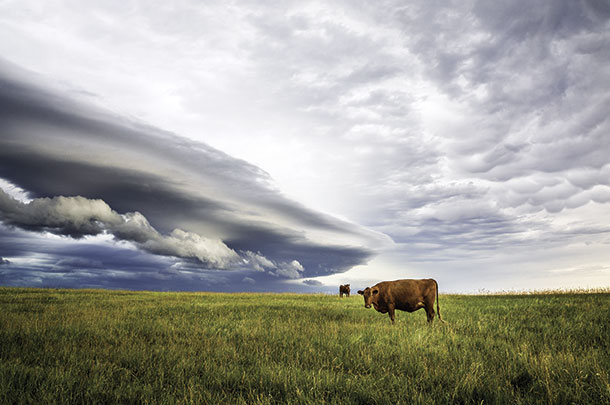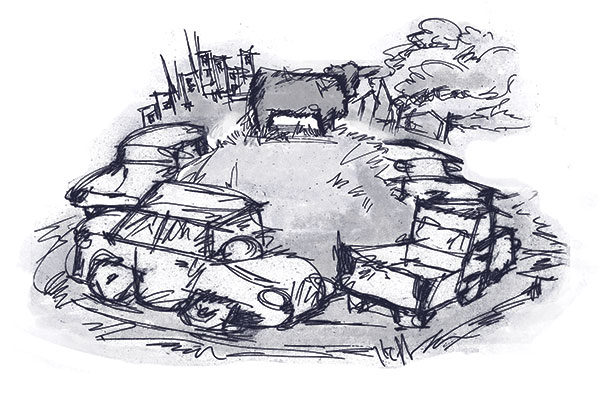Climate change is an important, ongoing issue in both social and scientific worlds. As beef encompasses both realms, it is paramount we continue to remain educated and vigilant about the impact our industry has on the atmosphere we share, specifically in terms of greenhouse gas (GHG) emissions.
Historically, cattlemen have been among the first to sincerely care about the environment. After all, air, soil and water are at the root of beef production. But for some reason, in recent years livestock have gotten one of the worst reputations for environmental care. “Meatless Mondays” and “meat alternatives” are now associated not only with dietary preferences but a sort of environmental stance. It begs the question, why now and why cattle specifically?
Widespread misinformation
According to Dr. Frank Mitloehner from the University of California, Davis, a lot of issues went mainstream with Livestock’s Long Shadow, a 2006 publication by the United Nations’ Food and Agriculture Organization.
“They claimed livestock production produces more global emissions than the transportation sector. I questioned that narrative, and the authors later agreed that livestock and transportation are not comparable,” Mitloehner said. “They came to their conclusion because they used different methodologies. They used one called life cycle assessment for livestock, but they only looked at direct emission for transportation, tailpipe emissions, and that is an apples to oranges comparison.”
Unfortunately, misinformation like this is still used in argument today. Another side to the issue is how the media has tapped into public concern about the climate and connected it with the universal need for food. Recently, fast-food giant Burger King was called out by the animal agriculture and scientific communities over their commercial music video, “Cows Menu,” containing misinformation about methane production and how lemongrass in cattle diets would decrease the carbon footprint of Whoppers.
Understanding GHGs and beef production
To engage in meaningful discussion about the realities of climate change and the beef industry’s impact, producers need to understand what GHGs are and how cattle contribute to them. As with any product made for human consumption, there are emissions that impact the atmosphere.
The foremost GHG emitted by ruminants is methane (CH4), which is produced in the rumen and released through belching or manure, essentially lost energy after metabolic requirements are fulfilled. Carbon dioxide (CO2) contained in methane comes from atmospheric CO2 fixed by photosynthesis into the cellulose of plants the animal consumes.
While methane is very powerful in absorbing heat in the atmosphere, it has a very short life, about 10 to 12 years, before it is destroyed in a process called hydroxyl oxidation where it is converted back into CO2, making it recycled carbon in the atmosphere.
Dr. Agustin del Prado of the Basque Centre for Climate Change explains this is very different from the CO2 emitted by burning fossil fuels, which adds additional carbon to the atmosphere.
“This is very important when we try to understand the effect of cattle emissions on the accumulation of GHGs in the atmosphere or the warming itself produced,” he explains. “This short time life of methane means if we do not increase our emissions from year to year, we would not be adding additional warming to the atmosphere. We can do this by not changing our herd numbers or/and reducing their emissions per head.”
Fact checking
Knowing what emissions look like from cattle and how they all fit into the cycle, it’s helpful to know where beef production stands alongside other major industries.
“The key thing is that quoting the U.S. EPA, about 2 percent of GHG emissions come from beef cows specifically. Our impact is not zero; we do have a contribution, but it’s also definitely not the main source,” explains Dr. Sara Place, chief sustainability officer for Elanco, noting transportation contributes 28% and electricity 27%.
It is also important to note that none of these statistics are or ever have been static. EPA data from 1990 to present shows there has been a reduction in GHG emissions from cattle per pound of beef by 6%.
“That’s because of the efficiency and innovation that the beef industry has adapted and continues to adapt,” Place continues. “I think of the major misconceptions that folks don’t hear about is change over time; they don’t realize there have been efforts in place. I would say based on the imagery that keeps coming out, there needs to be a lot more progress in getting people focused on this.”
Cutting beef is not the solution
Misinformation has pushed consumers to think that reducing beef consumption is a significant way to improve their individual carbon footprint. Not only is this common rhetoric misleading, it also overlooks important contributions the beef industry makes towards a more sustainable future and a healthier climate.
“Many times, there are claims that reducing our meat consumption is one of the most important things we can do in our lifestyle to reduce our impact on the climate,” says del Prado. “The scope is fairly limited of how much one can do on the environment reducing meat consumption. Many of these claims have serious limitations.”
For example, carbon footprinting doesn’t consider how methane emissions do not add additional warming to the climate compared to other GHGs. Often, when comparisons are done between the footprint of food products, the measurements are expressed per weight of food instead of per nutritional value, discounting the nutrient density of meat compared to other products.
Beef also has value in being a very unique protein source due to cattle utilizing rangeland and grasses as part of the nutrient cycle.
Place says, “There’s a huge amount of carbon that’s stored in grazing land all across the United States in public and private land. As a carbon sink, land which absorbs more carbon than it releases, it’s such a valuable resource to society, and anything we can do to increase carbon capture in those working lands is another huge part of that story about how beef can be part of the climate solution.”
Communicating this information and correcting misinformation is an important thing the beef industry needs to be doing. Dr. Mitloehner is on Twitter @GHGguru and recently began a thread in response to a United Nations tweet which encouraged people to reduce meat consumption on the claim animal agriculture produced more GHGs than all of big oil combined.
“Just to give you an idea, the top 20 big oil companies in the world produce 30 percent of all GHGs. That is twice as much as all livestock and poultry in the world combined,” he says in his reasoning. “If you look at the top 100 fossil fuel producers in the world, they emit 70 to 80 percent of all GHGs in the world. It’s not helpful for the UN or others to come out with stuff like that.”
Mitloehner noted as a result of questioning by himself and others in the scientific community, the UN withdrew their tweet.
Another part of having good conversations is understanding what the industry is actively doing to try to reduce emissions and why it’s the right thing to do. Manure handling and collection in systems like biogas digesters can go a long way in not only reducing emissions, but putting them toward clean energy. Likewise, greater nutrition and feed additives are being implemented more frequently to reduce methane output.
 Getty Images.
Getty Images.“I think it’s important to give people affirmative, transparent examples that when you buy beef, you are supporting all these positive outcomes. You’re supporting climate solutions; you’re supporting wildlife habitats; you’re supporting water quality, because that’s really what beef provides,” says Place. “If we are going to have a sustainable future, we need cows and ruminants in it.”






